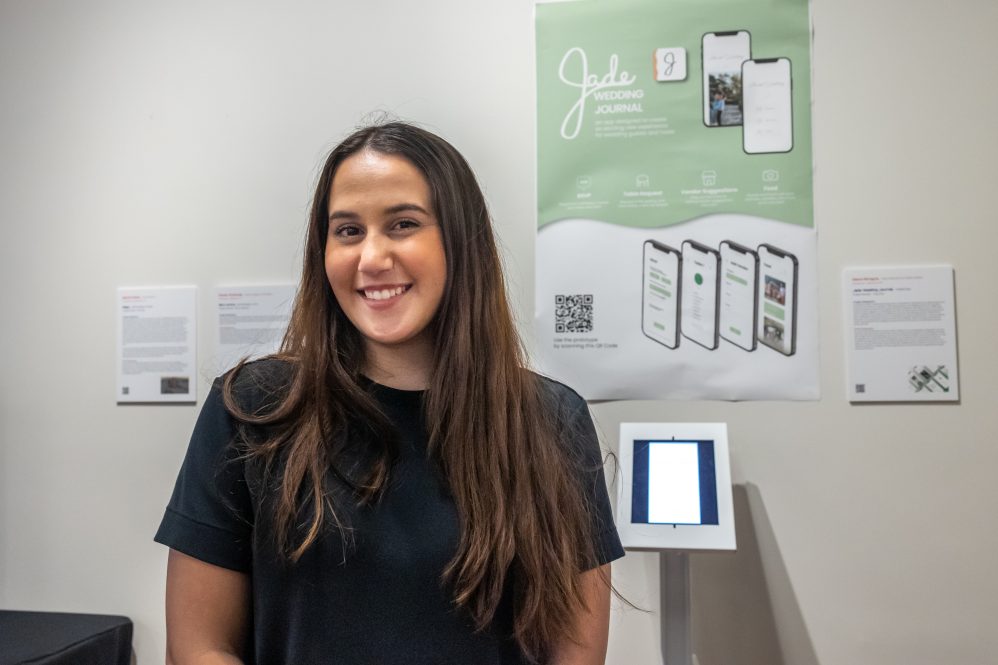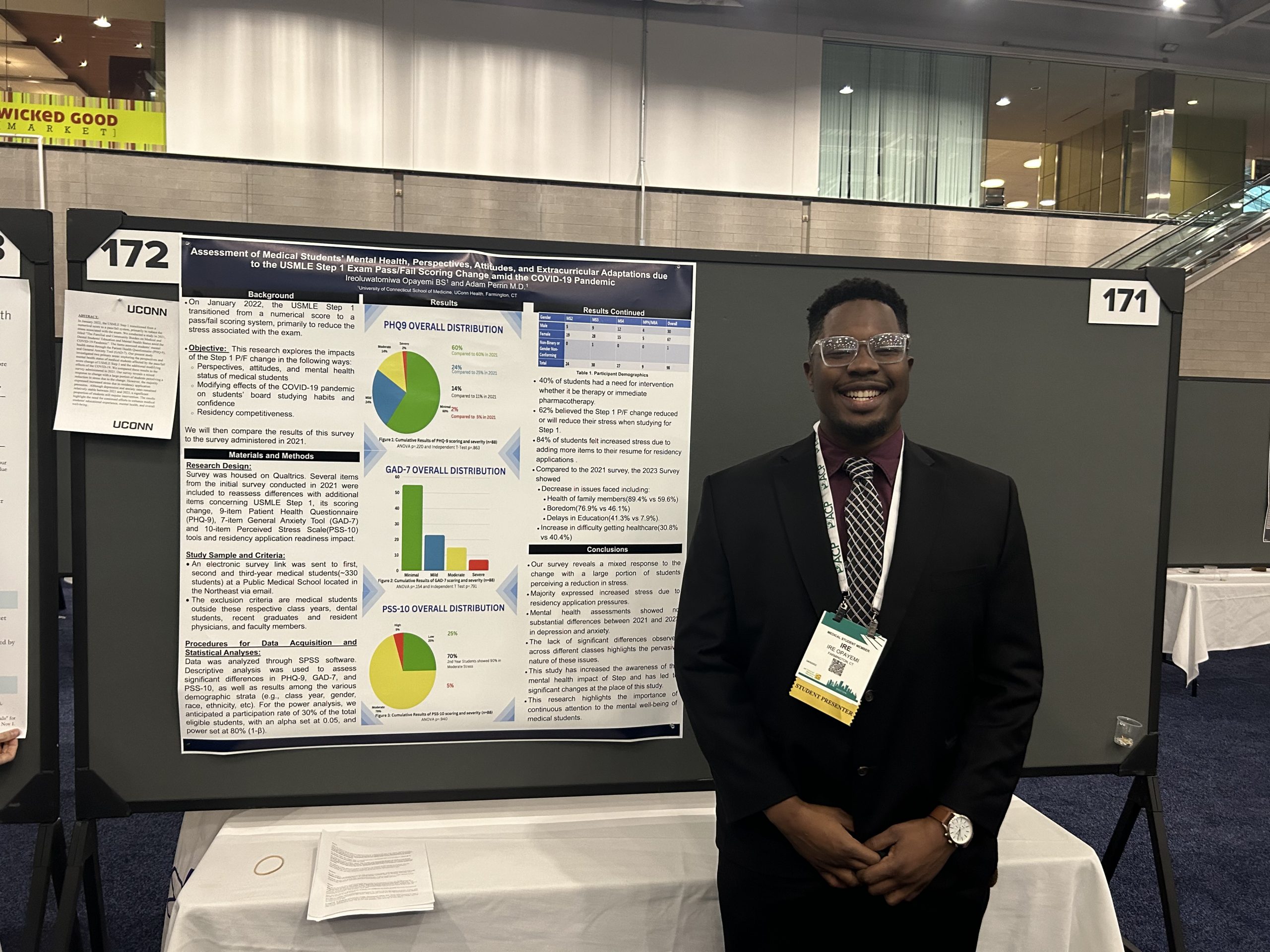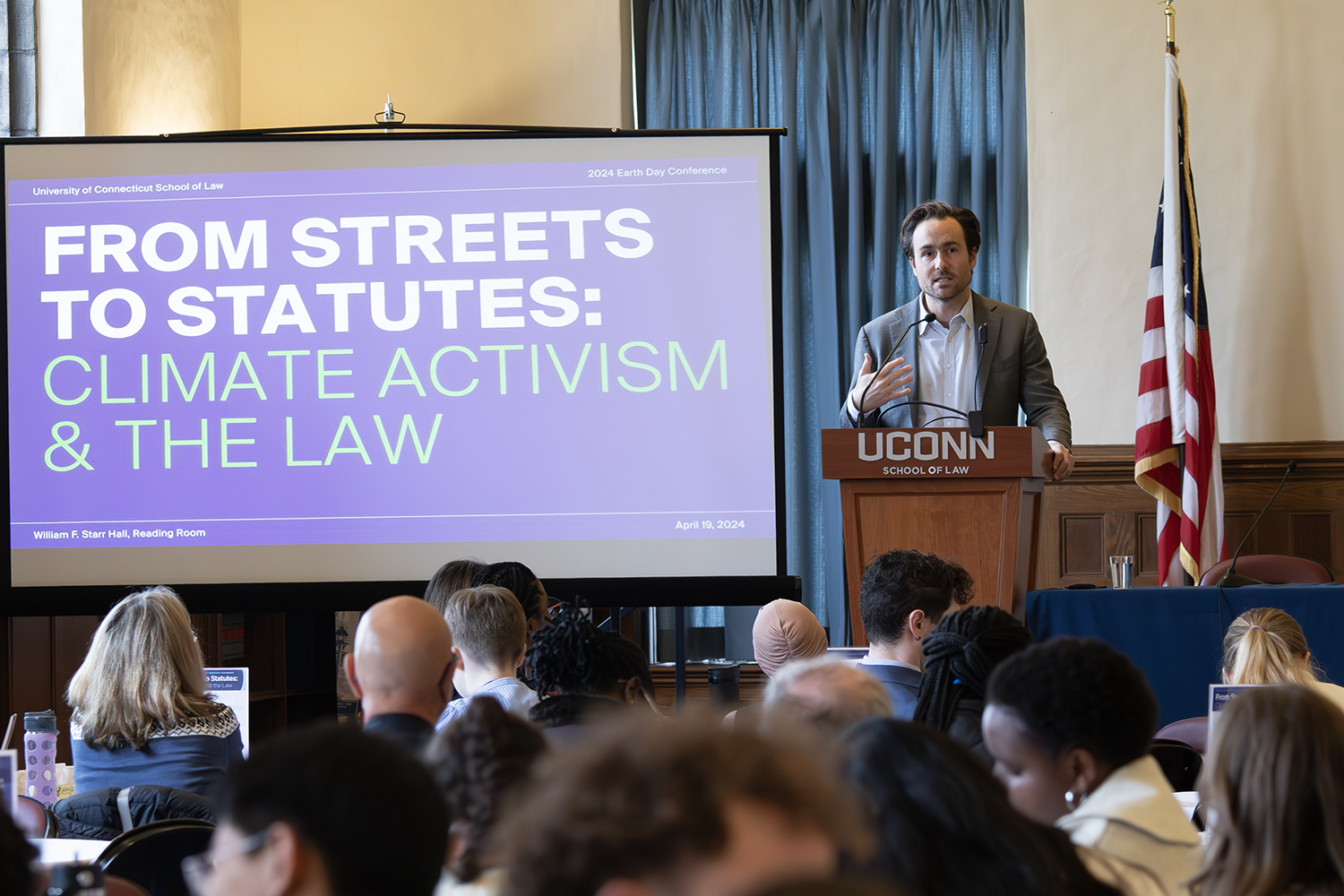Years beyond their middle and high school careers – in one case by nearly two decades – and they’re still listening to their teachers.
Kelsey Tynik ’12 (SFA), ’23 MFA says she often draws on skills gained from her middle school home economics teacher, and Giana Adragna ’23 (SFA) points to high school graphic and web design classes as strong influences in her work today.

In the backstory to her latest project, Lexy Vecchio ’23 MFA mentions the teacher, not even from her own school, who came to her aid when she was at her most vulnerable, and Zaire Diaz ’23 (SFA) smiles broadly when she recalls that a high school teacher bestowed on her the nickname DRC, a happy moment in otherwise challenging teenage years.
As graduating students from Digital Media & Design and the Art and Art History department, each with work on display in three on-campus exhibitions this month, these four might have produced vastly different final projects, but they’re connected – like so many who’ve drawn on previous experiences for inspiration – to their formative pasts.
Playtime as work time
With an undergraduate degree in illustration and art history from UConn, Tynik for many years worked in New York City as a window decorator for a contemporary fashion brand. Seeking a break, she left that job to nanny young children, putting her in the position of watching kids at play and considering how that might look for her.
“I noticed with the kids that their version of play is fun, light, and fearless. They’ll try anything,” she says. “But there’s a system to their play that’s structured yet freeing at the same time.”
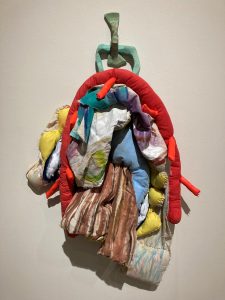
As she reconnected to her painting roots, Tynik says she longed to “pluck my work off the wall and break the frame.” That’s when she started to play, taking painted canvas off the stretcher and sewing it into shapes large and small to create 3D wall paintings, like “And cry at the same time when a capering circus clown approaches,” which is on display at the William Benton Museum of Art.
She says she uses Stephen King novels – she’s a fan of horror novels and their own playful structure – as inspiration not just for her work, but also the titles for many of her pieces. In the case of “Capering Clown,” it looks like the remnants of a mischievous character that’s sucked itself into a rainbow of color.
“You know you want to get closer, but you don’t want to get too close in a way,” Tynik says, describing her work. “I like that boundary. It’s tricky when a lot of your work looks fun and friendly, because it is that, but it’s also important to have a boundary between the fun and the viewer. My goal is for people to say, ‘I want to touch it, but I don’t think I should.’”
Tynik also includes carved wood in her pieces, which means she built for herself not just a sewing area but also an enclosed grinding booth with a dust removal system in her work studio.
“It’s wild actually, and I feel like so much has come back to me that feels so familiar,” she says of the skills she gained early on in school. “Habits that I learned as a child, they’ve come back up in a professional sense.”
A little help to plan the big day
When everyone in Adragna’s extended family gets together, she says they total about 50 members, that’s including 17 first cousins, their spouses, and their children. Together, they comprise a large Italian family that likes to celebrate good times, oftentimes dancing the night away.
“We have a wedding almost every year,” Adragna says. “Even if we’re not in a wedding, we’re there for all the events. We love weddings in my family. We go all out.”
As Adragna set to designing an undergraduate DMD project that demonstrates her mastery of web and interactive media, she says she thought about her role as co-maid of honor in her sister’s upcoming nuptials – she’s sharing the job with her other sister – and her place in the wedding parties of seven previous ceremonies.
She also noted that her cousin is marrying this August and is in the throes of planning, so why not design an app that would be meaningful, helpful, relatable, and tied to the very thing in which her family has expertise.
“Jade Wedding Journal,” on display in the Jorgensen Gallery, allows wedding guests to participate in the planning process, differing it from the legions of other apps that help brides and grooms check off items on their to-do lists.
The app allows guests to RSVP, post pictures and updates on a feed, and even make vendor recommendations to the hosts – an idea that came from Adragna’s mom. But its biggest asset might just be guests’ ability to request a specific table and see the table seating arrangement.
“We had a second cousin who had a wedding last year and we didn’t know until we got there if we’d be sitting together as an immediate family. It would have been nice to have that verification beforehand,” she says.
The feature also would be helpful if a guest is a friend from high school, who might not know many family members and who would like to see whether other friends from high school are at their table, Adragna says, explaining that she’s always been a savvy planner and wanted her project to have the ability to relieve the stress of a host who might not be.
“Jade, the stone, means growth and prosperity and new beginnings,” she says of the app’s name. “Green is also a color of growth and the earthtones really spoke to me with the romance of it all. With the name and the color scheme, I really wanted them to be something that’s very meaningful.”
Experiencing PTSD through gaming
Vecchio used to get panic attacks in school and suffered from emetophobia, or the fear of vomiting, that was so severe, she says, if a fellow student threw up in a bathroom, she wouldn’t talk to the person for a week or ever again use those facilities.
Years of misdiagnoses plagued much of her later childhood, she says, and only in her older teenage years did doctors connect the behavioral issues to PTSD that resulted from a skiing accident she had when she was 11 and broke her hip after attempting a maneuver she’d seen some snowboarders do.
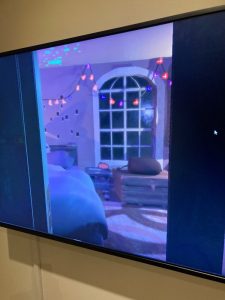
She landed the trick and had only 20 feet to stop before going over a cliff, she recalls, explaining that in the process of stopping she snapped her femur in half, missing her femoral artery by a centimeter, and blacked out off the trail in an isolated area.
“I don’t know exactly how long I was on the mountain. From what I understand, it was probably two hours since I’d only done one ski run. There’s a lot of time dilation I really don’t remember, but I was calling for help for so long,” she says, explaining she didn’t even know she was hurt until she tried to stand.
A child about her age eventually heard her calls, and they sought their teacher for help and later the ski patrol. Vecchio was in a wheelchair for three months and on crutches another three, yet everyone expected that given the presumed resiliency of an 11-year-old, she’d bounce back.
Then entered her behavioral issues.
Her therapist helped her discover the panic attacks were triggered by situations that threatened isolation, she explains, and the emetophobia likely resulted because over those two hours on the mountain certain bodily functions probably started to shut down along the vagus nerve, causing severe stomach pain that she never consciously felt thanks to the trauma.
Now as a DMD graduate student looking for a final project, she knew she wanted to produce an embodied experience geared toward those with a disability, Vecchio says. When an initial idea was thwarted during pandemic shutdowns, she turned to personal experience.
“Here There Be Bears” is an escape-room style, first-person video game on display at the Benton that’s shown mostly in flashback and traps the player in a cave with a bear.
“One of the reasons we chose a cave is because of its isolation factor,” she says. “You’re isolated, alone, mimicking when I was 11. Cellphones were not a thing then, so there was no way to call for help and in a cave cellphones don’t work.”
Vecchio says she wanted to use an accident-based trauma because it’s an isolated event, and most of the population won’t experience PTSD from an accident like the one portrayed – getting trapped in a cave with a bear.
“In the game, you are not a sexual assault victim or a combat veteran, both of which comprise the majority of those with PTSD,” she says, noting that despite PTSD being widely known about people don’t really understand it.
“It’s a misconception that people who haven’t seen combat can’t really get PTSD,” she says, “and PTSD is so often used as a joke, like when people say, ‘I was triggered by that.’ Those misconceptions persist so people don’t understand what PTSD means or how it manifests in people who aren’t your stereotypical post-traumatic stress survivor.”
Changing the past by drawing it
Diaz describes herself as always being artsy, but she didn’t get to study art until coming to UConn.
She attended a high school that centered on nursing, which imprinted the importance of giving blood and knowing CPR, she says, but didn’t give her much in the way of art lessons, save a health teacher who allowed Diaz to draw, label, and describe the function of the heart instead of taking a multiple-choice test.
Another teacher nicknamed her DRC, because the country Zaire is now known as the Democratic Republic of the Congo.
Home is where she got to create characters – how they look, their backstories, their families – and put them in more positive situations than she was experiencing at school, where not only was she studying a field outside her interest, but she also was navigating her gender identity.
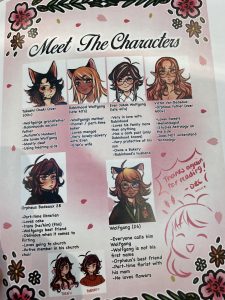
“When I came out as nonbinary and demisexual, I tried to tell a teacher or two who I trusted, but they kind of shut it down and weren’t really accepting of my coming out,” Diaz says. “Because of that I shut myself out and stayed in the closet. Growing up, kids talked about boys and girls and dating, and for me I didn’t feel any of this. People made it seem like I was the strange one because I wasn’t thinking about being intimate or dating.”
The characters she created, “I used them to cope and illustrate things that I wished people would do or how I hoped people would have reacted when I came out because it wasn’t really great, unfortunately,” she adds.
Diaz says the purpose of “A Confession In March,” her undergraduate graphic novel that’s on display in the Art Building, is to give those who are still figuring out their identity a way to feel safe.
“In the story, the main character, Wolfgang, is starting to develop feelings for his best friend. He’s never felt emotions toward other people before that were outside of being platonic and he’s like, ‘Oh, my goodness, what is this?’ I used Wolfgang as a lens of what I went through,” Diaz says, reinforcing that the purpose of the story is for “people to realize they’re valid, whether they’re straight, gay, bi, demi, ace, like I am.”
In a way, she might very well be saving a life, in a same-but-different-way as a nurse.
“I always want my art to be a place where someone feels comfortable and valid, because I never felt that and I want people to feel that. When you don’t have support, you feel alone. I always, especially through my art, want someone to look at it and say, ‘Someone’s out there for me.’”
The 2023 Studio Art and Digital Media & Design MFA Thesis Exhibition – “Breadcrumb Journeys” for DMD and “Closed Switch” for studio art – is open at the William Benton Museum of Art through May 7. The 2023 UConn DMD BFA Senior Exhibition “Limitless” is open at the Jorgensen Gallery at the Jorgensen Center for the Performing Arts through April 28. The 2023 Department of Art and Art History BFA Senior Exhibition is open in the Art Building in the Fine Arts Complex through April 28.
